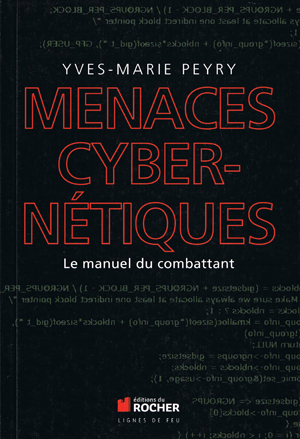
Le manuel du combattant
Menaces cybernétiques (Cyber threats)
For bilingual readers, here is an excellent book filled with practical information that is not catering only to computer science specialists. It is filled with advice that should help you avoid trouble when using your electronic devices. But, before going any further, here are some facts that may be of some interest to you:
1. The Pentagon has to deal with 250,000 direct threats every hour against its computer systems. Since the attacks may sometimes use as much as one million computers simultaneously, the Pentagon uses seven million computers to protect its different systems.
2. A password using 10 characters (no punctuation signs, no special characters) can be deciphered within ten minutes (and not only by a pro). You must add punctuation and special characters in your password in order to make it more difficult to decode. This password must be at least 10 characters long.
3. In 2012, there were 250 million zombie computers across the planet. A zombie computer can be your own computer taken over to launch many types of attacks without you knowing. It uses the resources on your computer without your authorization. This book offers a simple method to verify the integrity of your operating system, which can be done in a few seconds. You do not need to hire expert help.
4. 80% of businesses ignore that they are victims of cyber spying. We had a good example with Sony’s movie, “ The Interview” in 2014.
5. The global cost of cyber crimes in Europe, in 2012, was estimated at 750 billion euros. One internet user out of four was a victim of some kind of cyber crime in 2012.
6. At least 100,000 people are working in total secrecy for the United States in order to prepare attacks against external servers. In China, it is estimated that 300,000 employees are working on the same goal. Naturally, many other countries make significant efforts in this endeavor, like Russia, Iran and Israel, to name a few.
The book includes numerous and simple explanations aimed at helping everyone to be aware of the methods used by cyber spies. Politicians and businessmen can certainly benefit from the suggested improvements with regards to the use of personal electronic devices.
Cyber criminality is also discussed, and excellent advice is given to help everyone fight malware programs. You are also provided with a simple method to show you how to react if you ever are victim of ransomware. Some practical information is also provided to help protect your personal data, particularly your confidential banking data.
The author explains the difference between a virus and an IT worm. Few extremely sophisticated IT worms are presented, like STUXNET. This worm was used against Iranian nuclear installations in order to slow down their research program. You can learn about other worms like FLAME, GAUSS and SHAMOON.
The indirect risks resulting out of the use of viruses and IT worms are not negligible. When an IT worm is discovered within a computer system, its architecture becomes accessible to everyone. Criminal networks can then replicate or try to modify the IT worm, through reverse engineering, to new ends.
The reader learns how a classical DDOS attack is performed. There is also information about radio electric attacks that target telecommunications.
The book offers a number of interesting website resources, including:
1. If you think that there is an intrusion in your network: http://sourceforge.net/projects/ipscan
2. To locate an IP address: cut and paste all the source code information included within the e-mail and analyse it through the following site: http://www.iptrackeronline.com/email-header-analysis.php
3. To encrypt your important data: http://www.truecrypt.org/
4. For anonymous use of internet, the book suggests that you use a VPN: http://cyberghostvpn.com/. There is also a possibility to download the TAILS suite at: http://tails.boum.org/about/index.fr.html jointly with Gparted: http://gparted.sourceforge.net/. Tails uses TOR to connect to internet.
The appropriate way to do back-ups is described in the book. If you are a social network user, you will have access to an entire chapter about Facebook and Twitter and others. The weaknesses in these networks as well as ways to protect yourself and the confidentiality of your personal information are described at length.
IT security within businesses is another important chapter. The author shows how the human factor is often neglected in the design of security strategy. The reader learns about the ways cyber spies manage to steal important data from companies. A few simple modifications of daily habits are sometimes just what is needed to prevent the loss of sensitive information.
In conclusion, this is a very interesting book that will help any reader to protect personal information stored in mobile devices and home or office computers.
Title: Menaces cybernétiques – Le manuel du combattant
Author : Yves-Marie Peyry
Éditions du Rocher, 2013
ISBN : 978-2-268-07513-6
Collection « Lignes de feu » directed by Daniel Hervouët